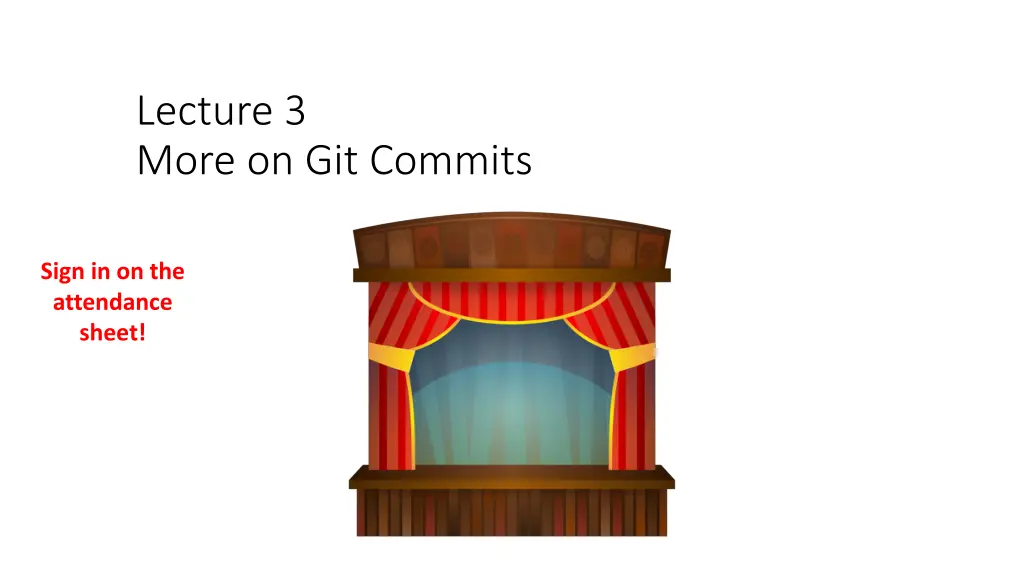
Understanding Git Commits: Workflow, Actions, and Best Practices
Dive into the world of Git commits with this comprehensive guide, covering the process of editing, adding, committing files, handling new, removed, and renamed files, unstaging files, and starting over on a file in the working directory. Learn essential Git commands and practices to enhance your version control workflow.
Download Presentation

Please find below an Image/Link to download the presentation.
The content on the website is provided AS IS for your information and personal use only. It may not be sold, licensed, or shared on other websites without obtaining consent from the author. If you encounter any issues during the download, it is possible that the publisher has removed the file from their server.
You are allowed to download the files provided on this website for personal or commercial use, subject to the condition that they are used lawfully. All files are the property of their respective owners.
The content on the website is provided AS IS for your information and personal use only. It may not be sold, licensed, or shared on other websites without obtaining consent from the author.
E N D
Presentation Transcript
Lecture 3 More on Git Commits Sign in on the attendance sheet!
Review: The Git Commit Workflow (Edit, Add, Commit) Working Directory Staging Area List of commits file1.txt (v2) file2.txt (v1) file3.txt (v1) bb2df1a (HEAD) file1.txt (v2) file2.txt (v1) file3.txt (v2) file1.txt (v2) file2.txt (v1) file3.txt (v1) git add file1.txt file1.txt (v1) file2.txt (v1) file3.txt (v1) 782cb4f file1.txt (v1) file2.txt (v1) ab628cc 1. Make changes to files vim file1.txt file3.txt 2. Add changes to the staging area git add file1.txt 3. Commit changes in staging area git commit -m fixed bug in file1.txt
What about new files? Working Directory Staging Area List of commits newfile.txt (v1) file1.txt (v1) file2.txt (v1) bb2df1a (HEAD) git add newfile.txt newfile.txt (v1) file1.txt (v1) file2.txt (v1) newfile.txt (v1) file1.txt (v1) file2.txt (v1) file1.txt (v1) file2.txt (v1) 782cb4f ab628cc file1.txt (v1) No difference from an edit, use git add newfile.txt.
What about removing files? Working Directory Staging Area List of commits bb2df1a (HEAD) file1.txt (v1) file2.txt (v1) git rm newfile.txt newfile.txt (v1) file1.txt (v1) file2.txt (v1) ___ newfile.txt (v1) file1.txt (v1) file2.txt (v1) file1.txt (v1) file2.txt (v1) 782cb4f ab628cc file1.txt (v1) git rm newfile.txt (also deletes newfile.txt from working directory!)
What about renaming files? Working Directory Staging Area List of commits betterfile.txt (v1) file1.txt (v1) file2.txt (v1) bb2df1a (HEAD) git mv newfile.txt betterfile.txt newfile.txt (v1) file1.txt (v1) file2.txt (v1) betterfile.txt (v1) file1.txt (v1) file2.txt (v1) newfile.txt (v1) file1.txt (v1) file2.txt (v1) 782cb4f ab628cc file1.txt (v1) git mv newfile.txt betterfile.txt
What if I want to unstage a file? Working Directory Staging Area List of commits git reset HEAD coolfile.txt coolfile.txt (v1) file1.txt (v1) file2.txt (v1) bb2df1a (HEAD) coolfile.txt (v2) coolfile.txt (v1) file1.txt (v1) file2.txt (v1) coolfile.txt (v2) file1.txt (v1) file2.txt (v1) newfile.txt (v1) file1.txt (v1) file2.txt (v1) 782cb4f ab628cc file1.txt (v1) git reset HEAD coolfile.txt (Note WD is unaffected)
What if I want to start over on a file (in the WD)? Working Directory Staging Area List of commits coolfile.txt (v1) file1.txt (v1) file2.txt (v1) bb2df1a (HEAD) git checkout HEAD coolfile.txt coolfile.txt (v2) coolfile.txt (v1) file1.txt (v1) file2.txt (v1) coolfile.txt (v2) coolfile.txt (v1) file1.txt (v1) file2.txt (v1) newfile.txt (v1) file1.txt (v1) file2.txt (v1) 782cb4f ab628cc file1.txt (v1) git checkout HEAD coolfile.txt
What if I want to start over (in both WD and SA)? Working Directory Staging Area List of commits coolfile.txt (v1) file1.txt (v1) file2.txt (v1) bb2df1a (HEAD) git reset --hard HEAD coolfile.txt (v2) coolfile.txt (v1) file1.txt (v2) file1.txt (v1) file2.txt (v1) coolfile.txt (v2) coolfile.txt (v1) file1.txt (v2) file1.txt (v1) file2.txt (v1) newfile.txt (v1) file1.txt (v1) file2.txt (v1) 782cb4f ab628cc file1.txt (v1) git reset --hard HEAD (overwrites entire WD!)
Summary: Manipulating the Staging Area To update the staging area with files from your working directory, use git add . To update the staging area with files from HEAD, use git reset . To delete files from the staging area, use git rm . That s how you manipulate the staging area. How about the working directory?
Summary: Manipulating the Working Directory To update files in the working directory, edit files with vim or your preferred text editor. To reset files in the working directory to how they were in a particular commit, use git checkout . If you want to reset the staging area at the same time (which is often the case), use git reset --hard (but with caution).
Ignoring files By default Git tracks everything in your repository Not always a good thing log files, compiled files, cache files, etc. Tell git to ignore these files using a .gitignore file https://github.com/github/gitignore for examples .gitignore * means anything, so any file that ends with .log *.log logs Build Standalone words are (usually) folders, so anything in logs/ or Build/ is ignored *.jar
Configuring Git Git has certain settings by default Provide Git with your name, email Customize Git to take advantage of its features, integration with other tools, different settings with special powers, etc. git config --global user.name "John Doe" git config --global user.email johndoe@example.com
Where we are This wraps up our discussion of how to make commits . So far, our commits were made in a very linear fashion every commit had exactly one parent, and had a maximum of one child. In larger projects, this probably won t happen the commits will begin branching off each other. Next week: branches
Activity Groups of two or three One person create a new Git repository using git init in a new folder Add some files and make some commits, write down your steps if you won t remember Ask the other person to try to work backwards and figure out a possible set of steps that brought the repository to this state Switch places and do this one more time
